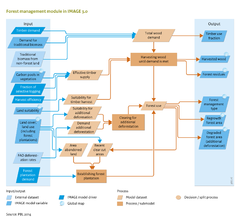Forest management/Data uncertainties limitations: Difference between revisions
Jump to navigation
Jump to search
No edit summary |
No edit summary |
||
| Line 15: | Line 15: | ||
===Limitations=== | ===Limitations=== | ||
Timber demand in IMAGE 3.0 is the sum of the demand for sawlogs, pulpwood and fuelwood. This total demand is than used in harvesting forests across the world, without knowing anymore the underlying wood types. So, forest plantations, for example, can used to fulfill the demand for either sawlogs of fuelwood. For specific assessments (e.g. for timber use for modern biomass), it would have been useful to remain the three wood types in the allocation. | |||
The timber demand in a region is the sum of local/regional demands and timber claims by other regions. The trade assumptions are adopted from external models, limiting the application of the model for cases with regional timber scarcity (which will change the total demand in a region). | |||
}} | }} | ||
Revision as of 10:02, 4 November 2016
Parts of Forest management/Data uncertainties limitations
| Component is implemented in: |
| Components: |
| Related IMAGE components |
| Projects/Applications |
| Key publications |
| References |
